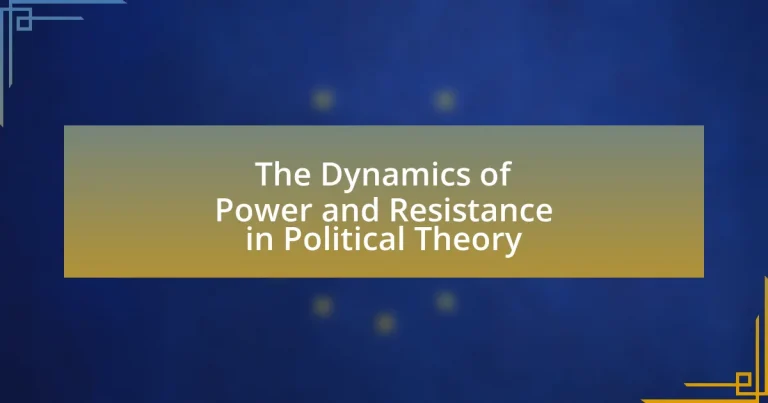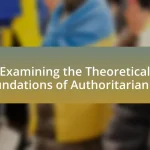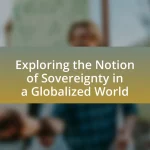The article examines the fundamental concepts of power and resistance within political theory, highlighting their interrelated dynamics in societal structures. It defines power as the ability to influence behavior and outlines various forms, including coercive, legitimate, expert, referent, and reward power. The article also explores how resistance manifests through collective actions, such as protests and social movements, and discusses historical and contemporary examples, including the civil rights movement and the Black Lives Matter movement. Additionally, it analyzes the implications of power dynamics in democratic and authoritarian systems, emphasizing the importance of understanding these concepts for social change and political engagement.

What are the fundamental concepts of power and resistance in political theory?
The fundamental concepts of power and resistance in political theory revolve around the dynamics of authority, control, and opposition within societal structures. Power is often defined as the ability of individuals or groups to influence or control the behavior of others, which can manifest in various forms such as coercive power, economic power, and ideological power. Resistance, on the other hand, refers to the actions taken by individuals or groups to oppose or challenge existing power structures, often aiming to achieve social change or justice.
For instance, Michel Foucault’s analysis of power highlights that power is not merely repressive but also productive, shaping identities and social norms. His concept of “biopower” illustrates how modern states exert control over populations through institutions and practices. Resistance is equally significant, as it emerges in response to power dynamics, exemplified by social movements that challenge systemic inequalities, such as the civil rights movement in the United States, which sought to dismantle racial oppression.
These concepts are interrelated; power generates resistance, and resistance can lead to the transformation of power structures. The interplay between power and resistance is crucial for understanding political dynamics and the potential for social change.
How do power dynamics shape political relationships?
Power dynamics significantly shape political relationships by influencing the distribution of authority and resources among individuals and groups. These dynamics determine how power is acquired, maintained, and challenged, affecting decision-making processes and governance structures. For instance, in authoritarian regimes, power is concentrated in a small elite, leading to limited political participation and resistance from marginalized groups. Conversely, in democratic systems, power dynamics are characterized by competition among various political actors, which can foster collaboration or conflict. Historical examples, such as the civil rights movement in the United States, illustrate how shifts in power dynamics can lead to significant changes in political relationships, as marginalized groups mobilize to challenge existing power structures and demand representation.
What are the different forms of power in political contexts?
The different forms of power in political contexts include coercive power, legitimate power, expert power, referent power, and reward power. Coercive power relies on the ability to impose penalties or sanctions, as seen in authoritarian regimes where dissent is suppressed through force. Legitimate power is derived from an established authority, such as elected officials who govern based on laws and social contracts. Expert power stems from specialized knowledge or skills, exemplified by advisors or technocrats influencing policy decisions. Referent power arises from personal traits or relationships, where leaders gain influence through charisma or public appeal, as observed in popular political figures. Reward power is based on the capacity to provide benefits or incentives, often utilized in political negotiations to garner support or compliance. Each form of power plays a crucial role in shaping political dynamics and influencing behavior within societies.
How does resistance manifest in response to power?
Resistance manifests in response to power through various forms such as protests, civil disobedience, and the establishment of counter-narratives. These actions serve as direct challenges to authority and seek to disrupt the status quo. Historical examples include the Civil Rights Movement in the United States, where individuals and groups organized marches and sit-ins to oppose racial segregation and discrimination, effectively demonstrating how collective action can challenge systemic power structures. Additionally, resistance can be expressed through art, literature, and social media, which provide platforms for marginalized voices to critique and oppose dominant ideologies. This multifaceted nature of resistance highlights its role as a crucial mechanism for social change and empowerment against oppressive power dynamics.
Why is the study of power and resistance important in political theory?
The study of power and resistance is crucial in political theory because it helps to understand the mechanisms through which authority is exercised and challenged within societies. Analyzing power dynamics reveals how institutions maintain control and how marginalized groups resist oppression, which is essential for comprehending social change. Historical examples, such as the civil rights movement in the United States, illustrate how organized resistance can lead to significant political transformations, thereby validating the importance of this study in shaping democratic practices and policies.
What historical events illustrate the dynamics of power and resistance?
The American Revolution (1775-1783) exemplifies the dynamics of power and resistance, as colonists resisted British imperial authority to establish an independent nation. This conflict arose from grievances over taxation without representation and British military presence, leading to organized resistance through events like the Boston Tea Party and the formation of the Continental Congress. The successful outcome of the revolution resulted in the establishment of a democratic government, illustrating how collective resistance can challenge and overturn established power structures.
How do contemporary movements reflect these dynamics?
Contemporary movements reflect the dynamics of power and resistance by challenging established political structures and advocating for social justice. For instance, the Black Lives Matter movement has mobilized millions globally, highlighting systemic racism and police brutality, thereby exerting pressure on political institutions to enact reforms. This movement exemplifies how grassroots activism can disrupt traditional power hierarchies and demand accountability from authorities. Additionally, the climate justice movement illustrates resistance against corporate and governmental negligence regarding environmental issues, pushing for policy changes that prioritize sustainability over profit. These movements demonstrate the interplay between collective action and institutional response, showcasing how societal demands can reshape political discourse and influence policy outcomes.
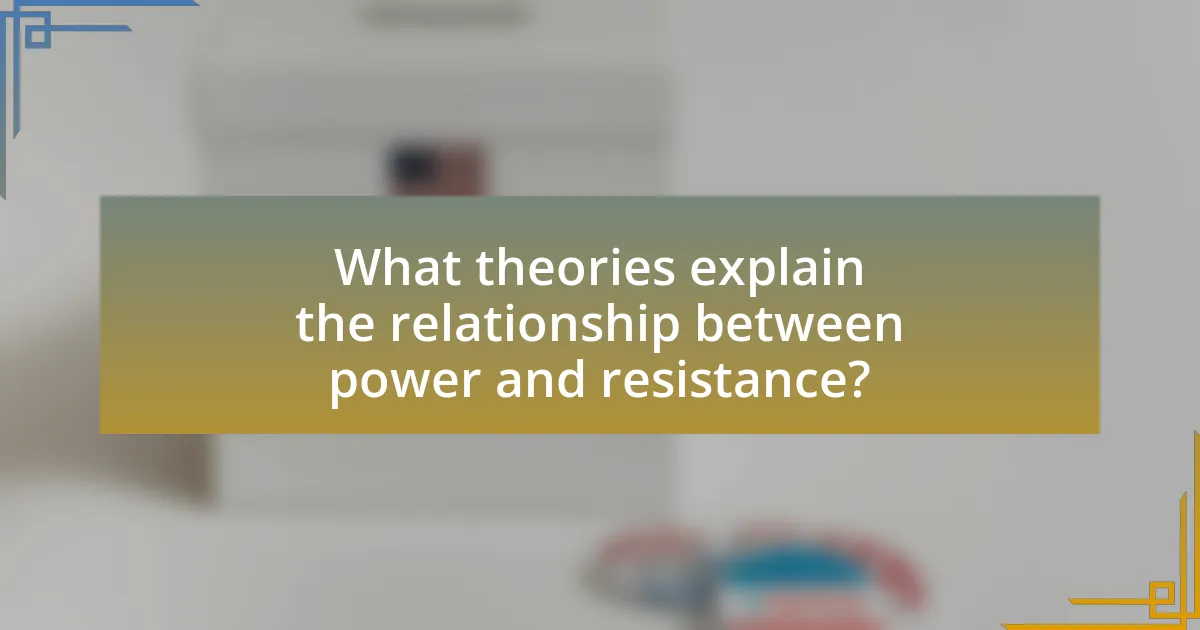
What theories explain the relationship between power and resistance?
Theories explaining the relationship between power and resistance include Michel Foucault’s concept of power/knowledge, Antonio Gramsci’s theory of hegemony, and the social movement theory. Foucault posits that power is not merely repressive but productive, creating knowledge and social norms that can be resisted. Gramsci emphasizes that power is maintained through cultural hegemony, where resistance occurs through counter-hegemonic movements that challenge dominant ideologies. Social movement theory analyzes how collective action arises in response to perceived injustices, illustrating the dynamic interplay between power structures and grassroots resistance. These theories collectively highlight that resistance is an inherent aspect of power dynamics, as power generates counter-responses that seek to challenge and redefine social relations.
How do classical theories address power and resistance?
Classical theories address power and resistance by emphasizing the relationship between authority and the governed. For instance, Thomas Hobbes posits that power is derived from a social contract where individuals surrender certain freedoms to a sovereign for security, highlighting the inherent resistance to absolute authority. In contrast, John Locke argues that power must be justified by the consent of the governed, suggesting that resistance is a natural right when authority becomes tyrannical. Additionally, Karl Marx critiques the power dynamics of capitalism, asserting that class struggle is a form of resistance against oppressive economic structures. These theories collectively illustrate how power is not only a means of control but also a catalyst for resistance, as individuals and groups challenge authority to reclaim autonomy and rights.
What insights do Machiavelli and Hobbes provide on power?
Machiavelli and Hobbes provide critical insights on power, emphasizing its necessity for order and stability in society. Machiavelli, in “The Prince,” argues that power is often maintained through pragmatic and sometimes ruthless means, suggesting that the ends justify the means in political leadership. He asserts that a ruler must be willing to act immorally when necessary to secure and maintain authority. Hobbes, in “Leviathan,” posits that power is essential to prevent chaos and violence in a state of nature, advocating for a strong, centralized authority to ensure social order. He believes that individuals consent to surrender some freedoms to a sovereign in exchange for protection and stability. Both thinkers highlight the complex relationship between power, morality, and governance, illustrating that effective leadership often requires a balance between ethical considerations and the harsh realities of political life.
How do Rousseau and Marx conceptualize resistance?
Rousseau and Marx conceptualize resistance as a fundamental response to oppression and inequality. Rousseau views resistance as a natural right of individuals against unjust authority, emphasizing the social contract where legitimate political power arises from the collective will of the people. He argues that when the government fails to reflect the general will, citizens have the right to resist and reclaim their freedom. In contrast, Marx frames resistance within the context of class struggle, asserting that the proletariat must rise against the bourgeoisie to overthrow capitalist oppression. He posits that resistance is essential for achieving a classless society, where the means of production are collectively owned. Both thinkers highlight the necessity of resistance as a means to restore justice and equality in society.
What are the contributions of modern theorists to understanding power dynamics?
Modern theorists have significantly advanced the understanding of power dynamics by emphasizing the relational nature of power and its manifestations in various social contexts. For instance, Michel Foucault’s concept of power as decentralized and pervasive highlights how power operates through social institutions and practices rather than being concentrated in a single authority. This perspective is supported by Foucault’s analysis of disciplinary mechanisms in society, which illustrates how power shapes individual behavior and societal norms.
Additionally, Judith Butler’s work on gender and performativity challenges traditional notions of power by demonstrating how identities are constructed through repeated social performances, thereby revealing the fluidity of power relations. Butler’s theories are grounded in feminist thought and underscore the intersectionality of power, showing how race, class, and gender interact to influence individual experiences.
Furthermore, Antonio Gramsci’s idea of cultural hegemony provides insight into how dominant groups maintain power through ideological consent rather than coercion, emphasizing the role of culture in shaping power dynamics. Gramsci’s analysis of the relationship between culture and power is evidenced by historical examples of social movements that challenge hegemonic narratives.
These contributions collectively enhance the understanding of power dynamics by illustrating the complexity and multifaceted nature of power in contemporary society.
How does Foucault’s perspective redefine power relations?
Foucault’s perspective redefines power relations by conceptualizing power as decentralized and pervasive rather than concentrated in institutions or individuals. He argues that power is not merely repressive but productive, shaping identities, knowledge, and social norms through discourse. This view is supported by his analysis of various social institutions, such as prisons and hospitals, where power operates through surveillance and normalization, as illustrated in his work “Discipline and Punish.” Foucault’s insights reveal that power is relational and exists in everyday interactions, fundamentally altering the understanding of resistance as an inherent part of power dynamics.
What role does agency play in resistance according to contemporary theorists?
Agency plays a crucial role in resistance according to contemporary theorists, as it empowers individuals and groups to challenge and oppose dominant power structures. Theorists like Judith Butler and Michel Foucault argue that agency is not merely about individual choice but is deeply embedded in social contexts that shape resistance practices. For instance, Butler emphasizes the performative nature of identity, suggesting that acts of resistance can disrupt normative power relations by reconfiguring social meanings. Foucault highlights how agency emerges through the interplay of power and knowledge, indicating that resistance is a form of agency that can manifest in various ways, from subtle acts of defiance to organized movements. This understanding underscores that agency is essential for enacting change and fostering social transformation within political frameworks.
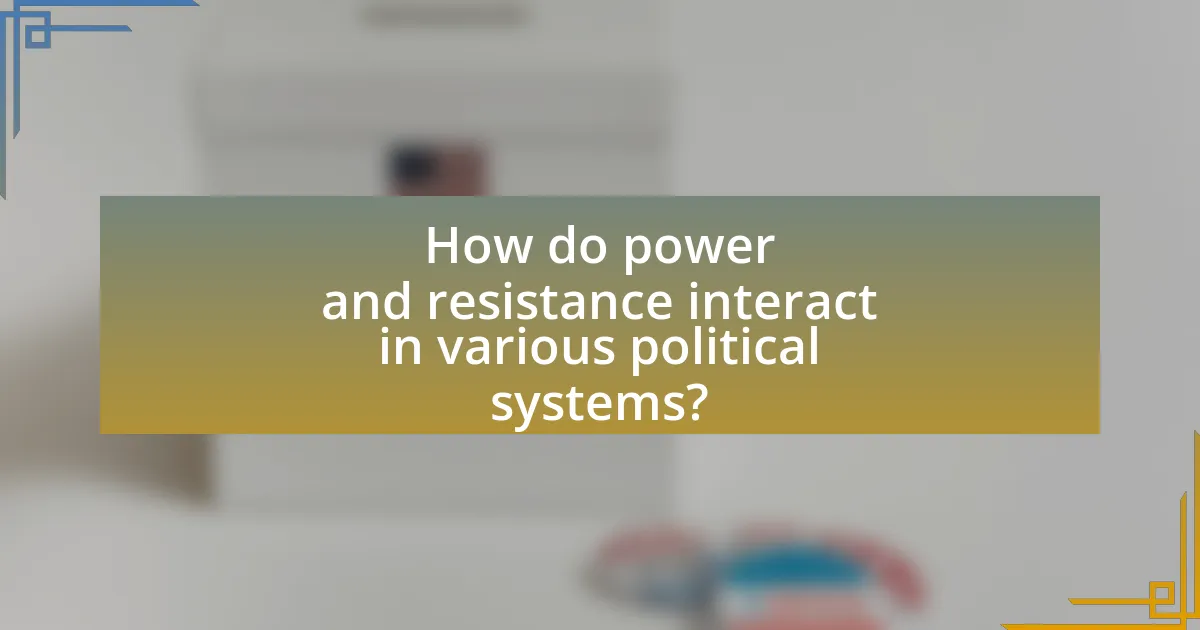
How do power and resistance interact in various political systems?
Power and resistance interact in various political systems through a dynamic relationship where power structures seek to maintain control while resistance movements challenge and disrupt these structures. In authoritarian regimes, for example, the concentration of power often leads to organized resistance, as seen in the Arab Spring, where citizens mobilized against oppressive governments. In democratic systems, power is more dispersed, allowing for institutionalized forms of resistance, such as protests and advocacy groups, which can influence policy and governance, as demonstrated by the civil rights movement in the United States. The interaction between power and resistance is thus characterized by a continuous struggle, where the effectiveness of resistance can lead to significant political change, reinforcing the notion that power is not absolute but rather contingent upon the presence and actions of resistance.
What are the implications of power dynamics in democratic systems?
Power dynamics in democratic systems significantly influence governance, citizen engagement, and policy outcomes. These dynamics determine how power is distributed among various actors, including government institutions, political parties, and civil society. For instance, the balance of power can affect voter representation and the effectiveness of checks and balances, as seen in the U.S. system where the separation of powers among the executive, legislative, and judicial branches aims to prevent any single entity from becoming too dominant. Additionally, power dynamics can lead to disparities in political influence, where marginalized groups may struggle to have their voices heard, impacting social equity and justice. Historical examples, such as the civil rights movement in the United States, illustrate how shifts in power dynamics can lead to significant social change and reform.
How does citizen resistance influence policy-making?
Citizen resistance significantly influences policy-making by compelling governments to reconsider or alter their proposed policies in response to public dissent. Historical examples, such as the civil rights movement in the United States, demonstrate how organized resistance can lead to substantial legislative changes, including the Civil Rights Act of 1964. This act was a direct result of widespread protests and advocacy against racial discrimination, showcasing how citizen mobilization can shift political priorities and prompt lawmakers to address societal demands. Additionally, research indicates that citizen engagement in resistance activities often leads to increased political accountability and responsiveness from elected officials, further reinforcing the impact of public opposition on policy outcomes.
What are the challenges faced by marginalized groups in democracies?
Marginalized groups in democracies face significant challenges, including systemic discrimination, limited political representation, and socioeconomic disparities. Systemic discrimination manifests through laws and policies that disproportionately affect these groups, such as voter ID laws that can disenfranchise minority voters. Limited political representation is evident in the underrepresentation of marginalized communities in legislative bodies, which can lead to policies that do not address their specific needs. Socioeconomic disparities are highlighted by statistics showing that marginalized groups often experience higher rates of poverty and unemployment, which further limits their access to resources and opportunities. For instance, according to the U.S. Census Bureau, the poverty rate for Black and Hispanic communities is consistently higher than that of white communities, illustrating the economic challenges faced by these groups in a democratic context.
How do authoritarian regimes manage power and suppress resistance?
Authoritarian regimes manage power and suppress resistance through a combination of coercion, propaganda, and control over institutions. These regimes often employ state security forces to intimidate and eliminate dissent, as seen in countries like North Korea, where the government uses surveillance and imprisonment to stifle opposition. Additionally, they manipulate media and information to shape public perception and maintain a narrative that legitimizes their rule, exemplified by the extensive censorship in China. Control over political institutions, such as the judiciary and electoral processes, further consolidates their power, preventing any meaningful challenge to their authority. Historical examples, such as the Soviet Union under Stalin, illustrate how these tactics effectively suppress resistance and maintain regime stability.
What strategies do authoritarian governments use to maintain control?
Authoritarian governments maintain control through a combination of repression, propaganda, and co-optation. Repression involves the use of state violence, censorship, and surveillance to suppress dissent and instill fear among the populace. For example, regimes like North Korea employ extensive surveillance systems and harsh penalties for dissent to deter opposition. Propaganda is utilized to shape public perception and promote the government’s narrative, often through state-controlled media that disseminate favorable information while discrediting critics. Additionally, co-optation involves integrating potential opposition figures into the regime’s structure, thereby neutralizing threats by offering them a stake in the system. Historical examples include the incorporation of former opposition leaders into the ruling party in countries like Venezuela. These strategies collectively reinforce the regime’s power and limit the scope for political pluralism.
How do resistance movements emerge in oppressive contexts?
Resistance movements emerge in oppressive contexts primarily as a response to systemic injustices and violations of human rights. These movements often arise when individuals or groups experience severe repression, discrimination, or exploitation, leading to a collective awareness of their marginalized status. Historical examples include the Civil Rights Movement in the United States, which emerged in response to racial segregation and discrimination, and the anti-apartheid movement in South Africa, which arose against institutionalized racial oppression.
The emergence of these movements is often facilitated by factors such as social networks, shared grievances, and the mobilization of resources, which help to organize collective action. For instance, the Arab Spring demonstrated how social media played a crucial role in uniting individuals against authoritarian regimes, highlighting the importance of communication in fostering resistance. Additionally, the presence of charismatic leaders or ideologies can galvanize support and provide a framework for action, as seen with figures like Nelson Mandela in South Africa.
In summary, resistance movements in oppressive contexts emerge from a combination of systemic injustices, collective awareness, social networks, and mobilization efforts, supported by historical precedents that illustrate these dynamics.
What practical strategies can be employed to navigate power dynamics?
To navigate power dynamics effectively, individuals can employ strategies such as building alliances, understanding the interests of various stakeholders, and practicing active listening. Building alliances allows individuals to create a support network that can amplify their influence and provide resources. Understanding the interests of stakeholders helps in identifying common ground and potential areas for collaboration, which can lead to more effective negotiation outcomes. Active listening fosters trust and respect, enabling clearer communication and reducing misunderstandings. These strategies are supported by research indicating that effective negotiation and collaboration often hinge on relationship-building and mutual understanding, as highlighted in studies on organizational behavior and political theory.
How can individuals effectively resist oppressive power structures?
Individuals can effectively resist oppressive power structures by organizing collective actions, utilizing nonviolent resistance strategies, and leveraging social media for awareness and mobilization. Historical examples, such as the Civil Rights Movement in the United States, demonstrate that organized groups can challenge systemic oppression through protests, legal challenges, and grassroots campaigns. Nonviolent resistance, as advocated by figures like Mahatma Gandhi and Martin Luther King Jr., has proven effective in dismantling oppressive regimes by garnering public support and drawing attention to injustices. Additionally, social media platforms have become powerful tools for individuals to share information, coordinate actions, and amplify marginalized voices, as seen in movements like the Arab Spring and Black Lives Matter. These methods collectively empower individuals to challenge and resist oppressive power structures effectively.
What role does education play in empowering resistance movements?
Education plays a crucial role in empowering resistance movements by equipping individuals with critical thinking skills, fostering awareness of social injustices, and promoting collective action. Through education, members of resistance movements gain knowledge about their rights, historical contexts, and strategies for effective advocacy. For instance, the Civil Rights Movement in the United States utilized educational initiatives to raise awareness about racial discrimination, leading to organized protests and legal challenges. Additionally, studies show that educated individuals are more likely to engage in civic activities and mobilize others, as seen in various global movements advocating for democracy and human rights. This correlation between education and activism underscores the transformative power of knowledge in challenging oppressive systems.
